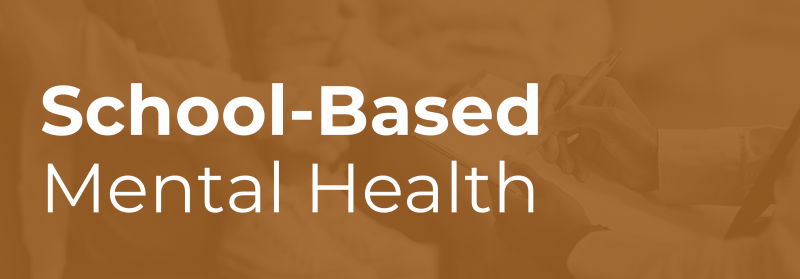School-Based Mental Health

School-Based Mental Health
The division is composed of a team of certified educators, school counselors, and licensed mental health professionals trained to support the needs of all Oklahoma students. This skilled team works to provide coaching, technical assistance, guidance documents, and professional development to districts across the state. The three Advancing Wellness and Resiliency in Education (AWARE) projects are also housed within this division.
School-based mental health services are delivered by trained mental health professionals employed by schools. These professionals include school psychologists, licensed mental health professionals, school counselors, school social workers, recreational therapists, and school nurses.
Schools work alongside guardians to address the needs of identified students. By removing barriers such as transportation, scheduling conflicts, and stigma, school-based mental health services can help students access needed services during the school day.
Children and youth with more serious mental health needs may require school-linked mental health services that connect youth and families to more intensive resources within the community. (Sourced from NAMI, 2022, nami.org).
Student Mental Health Protocol - Model Policy Guidance
New Oklahoma Mental Health Legislation became effective July 1, 2022. We know that there are many questions regarding this new legislation and the implementation of new policies and procedures in your schools. In response, the Division of School-Based Mental Health within the Office of Student Development has created a guidance document aligned to the recently released red book mental health legislation components.
Download Model Policy Guidance
School-Based Mental Health Implementation
The way school districts implement school-based mental health services vary. It may involve districts hiring school-based therapists or social workers as a component of their staffing structure. Those professionals can provide access to prevention programming, early identification of mental health challenges, and treatment options. Some districts may partner with community mental health organizations and agencies to develop an integrated, comprehensive program of support and services. The goal is to address the following;
- Selection and Implementation of evidence-based programs to provide a positive school climate and promote student skills in dealing with bullying and conflicts, solving problems, developing healthy peer relationships, engaging in activities to prevent suicide and substance use, and so on.
- Develop early intervention services for students in need of additional support such as skill groups to deal with grief, anger, anxiety, sadness, and so on.
- Develop treatment programs and services that address the various mental health needs of students.
- Develop student and family support and resources.
- Develop a school culture in which teachers and other student support staff are trained to recognize the early warning signs of mental health issues with students.
- Develop a referral process to ensure that all students have equal access to services and supports.
School-Based Mental Health Benefits
Studies have shown the value of developing comprehensive school mental health programs in helping students achieve academically and have access to experiences that build social skills, leadership, self-awareness, and caring connections to adults in their school and community (Durlak et.al., 2011).
Schools that also choose to collaborate with community partners have found that they can enhance the academic success of individual students. These partnerships have been found to significantly improve schoolwide truancy and discipline rates, increase the rates of high school graduation, and help create a positive school environment in which a student can learn and be successful in school and in the community (National Council for Community Mental Health, 2011).
Multi-Tiered System of Support
MTSS is a prevention-based framework structured to serve the needs of all students, and it is not a one-size-fits-all program. In equity-based MTSS, tiers organize students' needs and the allocation of available resources. An equity-based MTSS framework should build upon the school community's strengths, align with the students' needs while honoring all cultures, and moving the future of education forward (McCart & Miller, 2020).
Schools implementing an MTSS framework should focus on embedding trauma-informed principles and strategies to address students' and school communities' behavioral, and learning needs in these four core components:
- Data-Based Decision Making
- Sustainable Teaming System
- Evidence-Based Practices
- Continuous Improvement Cycle
Using MTSS is both a prevention and intervention framework. MTSS is used to address all students' and school communities' biological, behavioral functioning, and learning needs. The framework is scientifically proven to be highly effective for improving all student outcomes, addressing limited resources, and providing improved professional development in rural and suburban schools. The goals of trauma-informed and multi-tiered behavioral supports are similar in science. Both practices and interventions create a safe and predictable school climate, enhance the social environment, and reduce problematic behavior (McIntosh, Ty, & Miller, 2014).







